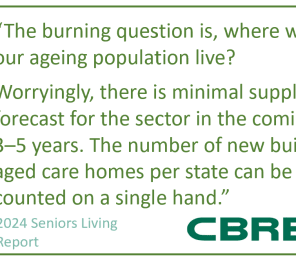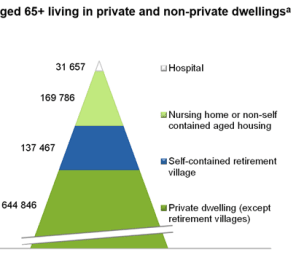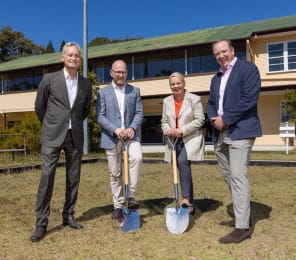Commissioner Lynelle Briggs (pictured above right) has cautioned that she won’t be handing over cash to providers without strings attached – and again questioned the sector’s enthusiasm for implementing the reforms in the Royal Commission’s Final Report as she did at the workforce hearings last October – in the final session of the workshops on the possible ‘Transition and Implementation’ of a new aged care system.
In the shortest session of the workshops – only an hour – Senior Counsel Assisting Peter Gray QC questioned just five witnesses around what actions need to be taken now before the Commissioners makes its recommendations on the final shape of the new system in November.
They were:
- Sean Rooney – CEO, Leading Age Services Australia
- Robert Bonner – Director, Operations & Strategy, Australian Nursing & Midwifery Federation (SA Branch)
- Sandra Hills OAM – CEO, Anglican Aged Care Services Group T/A Benetas
- Dr Henry Cutler – Director, Centre for Health Economy, Macquarie University
- Dr Nicholas Hartland PSM – First Assistant Secretary, In Home Aged Care, Department of Health (who was a late addition to the witness list for this session)
Mr Gray kicked off proceedings by bringing up a copy of the Commissioners’ objectives for this process from Consultation Paper 1 which require consideration of:
- older people receiving services under the current system and how continuity of service delivery is assured
- the culture and models of care that support service delivery
- market structures and business models through which services will be delivered
- the operation and performance of aged care providers
- the availability, skill levels and training of the workforce
- the role of Government in overseeing the system
- financial impacts for older people, taxpayers and providers.
Flagging these issues will probably be the subject of a future hearing – and LASA’s submission that moving to agnostic care subsidies would likely cause “significant disruption” – Mr Gray mostly received consensus from the panel on a range of potential actions, including:
An assessment of the financial viability of providers and a plan to provide continuity of care if services close their doors:
Dr Cutler (pictured bottom right) advocated for a model within the Government to provide continuity of care in areas where another provider is not easily accessible.
“I think we need to make sure that the services overall are able to survive and provide care and support in the way that we need them to,” Mr Bonner (pictured below left) added. “Does that mean that every provider needs to be sustained in the future? We would argue not. And they need to be sustained in a way that supports the shift in focus and change, not just to do the job that they are supposed to be doing now.”
Better data collection and analysis:
Dr Hartland revealed the Department has been able to link its data systems and their aged care data warehouse should be ready soon.
“We are doing some work about what we think the need groups are in the population, groups with similar characteristics, costs and risks and we are also doing some work on demand supply modelling and if we can connect those two we will be able to project what a needs based system likes look,” he stated.
Action on the aged care workforce:
The panel agreed the skills and training of the workforce has already been the subject of multiple reviews in the last 10 years and there was no reason to delay reforms.
An evaluation of funding if supply is uncapped:
A suggestion made by Dr Cutler. The health economist noted providers can only improve quality if funding is available otherwise services will be constrained.
“Offering greater competition can lead to a potential improvement in quality as providers try to ramp up their quality to attract residents or people with home care packages,” he explained. “So, providers need to respond to that incentive and they can only do so to the point whereby their revenue covers any increase in costs associated with increased quality.”
A quality performance framework to pick up any changes in the system as reforms take place:
Dr Cutler also made a persuasive argument for better independent oversight and transparent reporting on the progress of reforms, particularly those around quality, for example, introducing a quality indicator for wellbeing.
However, he warned against making too many changes now, saying it could lock the system into a specific direction which could be hard to reverse once the Commissioners’ final recommendations are implemented in the long-term.
“For example, we all agree that there is an unmet need in home care but increasing significant amounts of funding to home care packages when we don’t really know what home care is going to look like in two- or three-years’ time,” he said. “There may be some issues around whether it is then harder to change the system.”
A reduction in the national home care prioritisation queue:
Mr Bonner disagreed with this analysis however, backing Mr Rooney’s (pictured above right) calls for reducing the national home care queue now.
“If we do not act now, then there are people either trapped without services and deteriorating without care and support at home, or alternatively, they are escalating because of chronic health break down and turning up at the emergency department in our teaching hospitals and incurring massive cost and human suffering through that process,” he said. “So whilst I accept that you don’t want to be sort of turning the system upside down twice in short order, if we don’t deal with some of the issues that LASA have raised in their submission, it seems to me that we are going to be further behind the eight ball by the time we actually get to the time of major reform.”
Dr Hartland weighed in at this point, arguing the phasing was in his words, “really tricky”.
“If you uncapped residential care you would push more people into that system,” he said. “If you kept home care capped and the Royal Commission has observed that we are already too focused on residential care so you do need to be careful with that phasing. You need to be really careful about planning, the time lines of doing some of this complex work are really horrendous.”
“You mean they’re very long,” Mr Gray said pointedly.
“They can be very long,” Dr Hartland admitted. “We started work on single assessment May 2018 and the concept had been discussed before that and the current timing is to have that delivered in April 2021. You know with a more solid authorising environments by Royal Commission recommendation, things, barriers get cleared and a lot of the time lines are about taking the sector with you but these are no trivial tasks about these complex reforms. You have got to think about legislative design, IT design which is choosing technical solutions, building and then workforce implications being changed. So careful planning is really important.”
Commissioner Briggs indicated that she is not ready to recommend further funding for home care however, making an important point about getting providers to deliver on reforms.
“We’ve heard evidence in this Royal Commission at various times around how governments have provided additional funds for particular outcomes,” she stated. “And the industry has taken the funding and not delivered on the outcome. This is a pretty serious issue when we’re considering workforce issues more generally and how that funding gets to the appropriate place.”
“So, I’m a bit nervous about rushing in to just provide extra funds to the sector without the quid pro quo and the question from me is: how does the industry sign up to provide the quid pro quo?”
Mr Rooney acknowledged past funding measures have not provided the outcomes that were expected.
“You see this in lots of areas of government where, you know, we can be very loose about what the government wants, we can be very tight about you must spend the money this way and then very loose about measuring the outcomes,” he said.
However, the LASA CEO argued that the sector is keen to be clear upfront about how outcomes would be measured.
“If there was more investment coming into the sector, that would come with clear expectations around what performance and what outcome would be delivered and that needs to be measured and monitored and, you know, if you’re not meeting that, you need to be held to account,” he added.
Ms Hills (pictured above left) supported this argument.
“If I can just use an analogy for us, if I want to undertake some large project or transition or something like that and I go to my board and I say to them I want a lot of money to do this, I’m going to have to do a few things,” she said. “I’m going to have to put up a good business case that actually says this is my goal, this is the purpose, here is the cost benefits analysis, here is the risk, here is the risk strategy, here is how I’m going to monitor, here are the resources, here are my skills and I don’t get the money unless I do that.”
Commissioner Briggs didn’t seem convinced though.
“I agree, Ms Hill but the problem is that if a government asks that, it’s called red tape,” she responded. “And there’s an immediate rejection of the approach and, frankly, I think if the sector expects to get a lot of money, there are some hoops it’s going to have to go through in order to see that money delivered because the ultimate issue is the outcomes for elderly people and how we get them.”
The Commissioner was similarly blunt on the need for the leadership of the sector to get on board with the Royal Commission’s reforms – or leave.
“When we delivered our interim report, I think I was asked the question by some providers about what should we be doing and I can’t remember exactly but I think I said ‘Preparation for change’ or words to that effect,” she said. “And I think that’s what the sector needs to do. But on top of that, I think we need to think about what might some of the core elements of preparing for change would be. I think leadership is clear on that, governance, stewardship of the change is pretty important. Catalyst for change, new players in the system who aren’t the same people who talk to governments all the time and how those new players or new workers or whatever can be brought in to keep a process of reform going. Similarly, research about leading edge activities and how that is institutionalised and spread across the system are things we might talk about.”
“So, what I’m saying is can we raise the discussion up to that level,” motioning her arms up, “and anyone in the panel who wants to talk at us about these things, I would be pretty happy to hear that.”
If the Commissioner was hoping for an enthusiastic response, she was disappointed – her statement was met with an uncomfortable silence before Ms Hills jumped in.
“I would suggest that the sector is already looking at many of those areas but we really do need to come together and be far more united,” she conceded. “I think it’s unrealistic to think that we are ever going to get everyone following in the one trail. I think that’s unrealistic. And I think that there are, we can all talk about movements and things but, and I will talk about, I have already spoken about the work of the Workforce Council but certainly the work of many of the peaks, the work of NACA but we are talking about culture change, that’s one of the things I would also add to your list Commissioner.”
The Benetas CEO then repeated her statement from the CEOs panel at the workforce hearings that many in the sector are worn out by the number of reforms in recent years.
“People are tired, you know,” she said. “They’ve gone through reform; will they be ready to do more reform? Many of them are and some of them aren’t and that’s probably one of the things that is going to separate the wheat from the chaff etcetera which may or may not be a good thing but strong leadership is absolutely needed in the sector and I think people need to speak out more, perhaps be a bit more, you know, a bit more risky about what they’re doing and what they want to do. I could speak a lot on this subject but I will stop now. It is up to the sector; we have to lead.”
Mr Rooney added his voice to Ms Hill’s, echoing his past point that ageing needs to be elevated to national importance.
“There are more older Australians today than ever before,” he said. “And I don’t think, as a country, we have actually acknowledged that and when we come to those conversations as spot fires, more often than not the discussion is around this is a problem or this is a burden. And it’s in the negative. When in actual fact the starting point is hey, isn’t this a success of our society? What are we going to do as a society to support and enable those growing numbers of older Australians to continue to contribute to their families, their communities, the economy, in whatever way they choose, that is basically drawing dawn the dividend from their long lives contributing to this country? And I think that is a piece where we really need to elevate and that’s the opportunity, I think, as afforded through this process is to start to deal with those issues as well.”
“Thank you,” replied the Commissioner – but just like the CEO panel during October’s workforce hearings, the room was left with the impression the Commissioner was wanting more.










